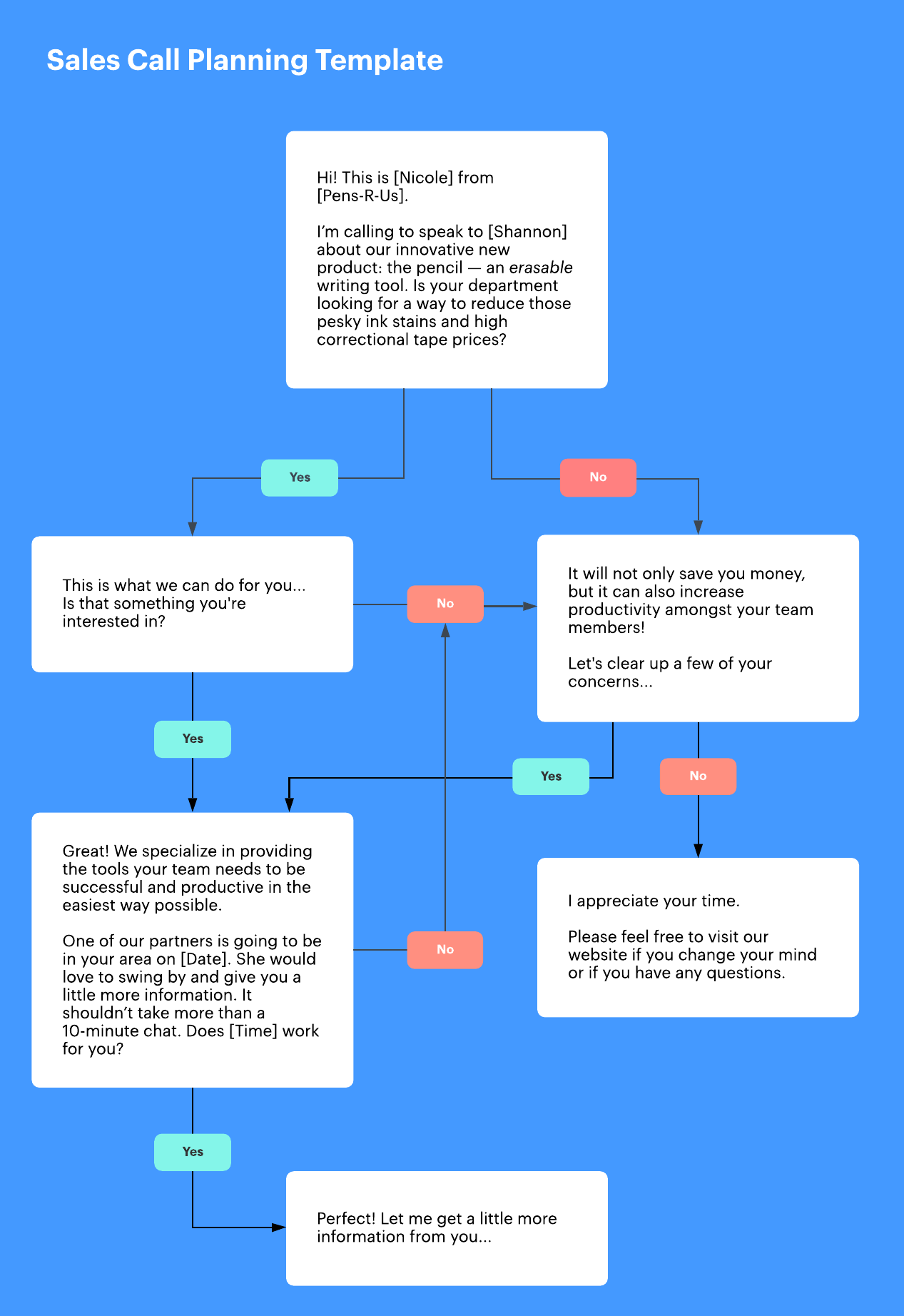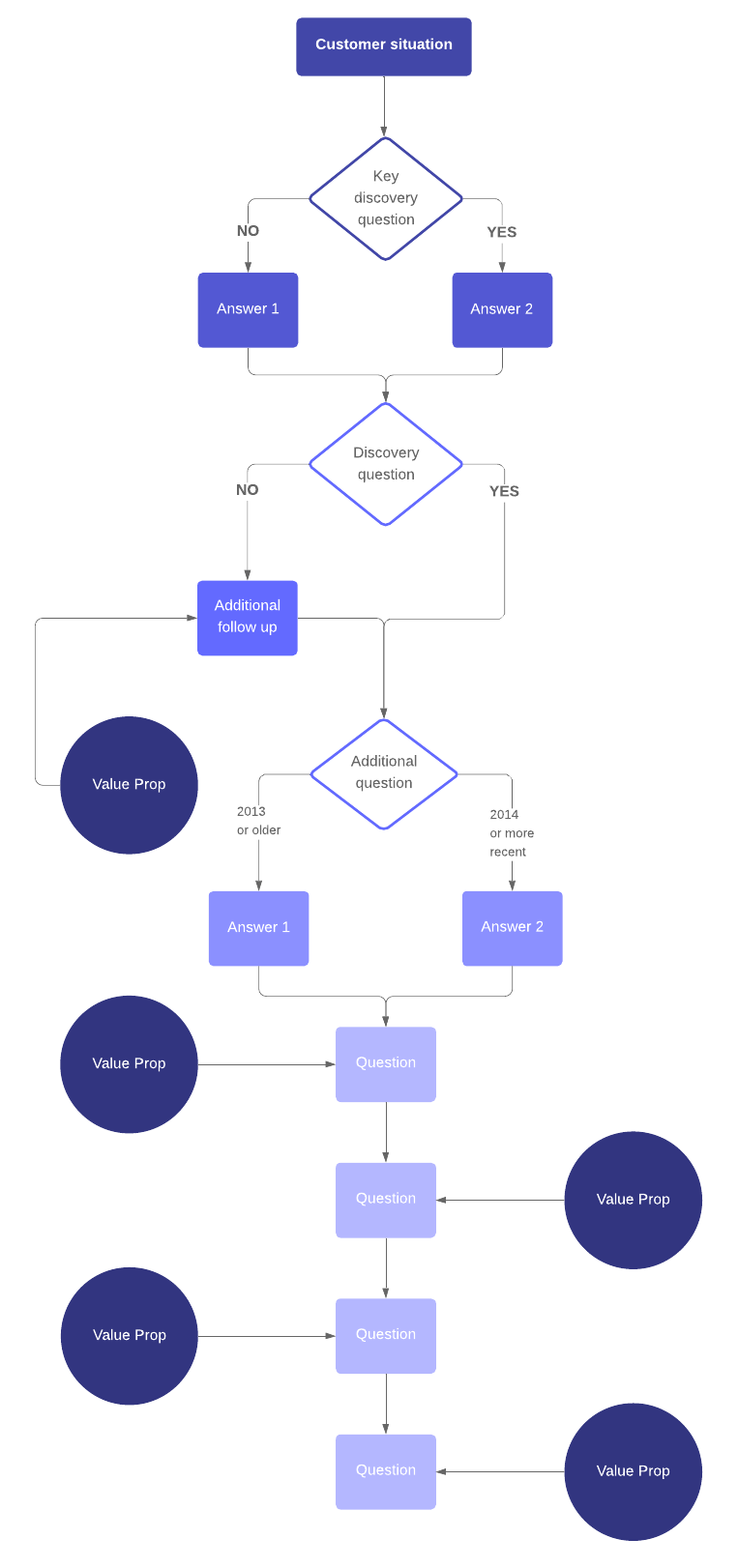As the saying goes, some people could sell a glass of water to a drowning man. But no matter how naturally skilled the sales representatives on your team are, they could still benefit from the guidance and consistency that sales call planning provides.
Planning a well-researched and practiced sales call will give your sales rep an advantage. Check out the basic steps that most sales teams include, and then set your team up for success with our sales call planning template.

What is a sales call?
In the simplest sense, a sales call is a meeting—either over the phone or in person—between a salesperson and a potential buyer. In many cases, it’s the first point of contact a seller has with a potential client.
Sales calls can transpire in a few different ways:
- Cold calls: Cold calls involve a member of the sales team calling prospective clients without any prior contact.
- Lead generation forms: Other sales calls are initiated through lead generation forms. For example, a customer may have visited your site and filled out a lead form with the expectation that a sales call might take place in the future.
- Purchase: Companies could also purchase a potential customer's information from a lead-generating business that collects information to repackage and resell to businesses.
- Direct contact: In rare cases, interested clients may call a business directly to initiate a purchase of goods or services.
However the sales call originates, first impressions are key, which is why your team needs a solid sales call planning template.
Why should you use a sales call planning template?
A sales call template organizes potential client questions and responses so sales representatives can be prepared to handle objections, highlight the product’s or service’s value, and close the deal. It can be as simple as a few notes scribbled on a spare piece of paper or as formal as a preset template or fill-in-the-blank guided worksheet. (At Lucid, we would recommend building a conversation tree as shown in the template above.) Decide within your organization what works best for your sales team.
If you create a sales call template, don’t feel like you have to follow it to the letter. You should still let the potential customer’s comments ultimately guide your conversation—sales call planning merely prepares sales reps and keeps messaging more consistent across the organization.
What should a sales call template include?
A sales call template is more than just a script—it helps you better understand the demographic you’re selling to. A basic sales script template should include the following components.
Intro
This is how you begin your call. Make sure to include your name, the company you work for, the person you’d like to speak with, and the reason for your call.
“Hi, this is [NAME] from [COMPANY]. I’m calling to speak to [NAME] about [X].”
Quick pitch
Cut right to the point with high-level, benefit-driven reasons how or why your product or service will help your customers.
“Our [PRODUCT/SERVICE] completely eliminates the need for multiple software solutions by [DESCRIBE BENEFIT/EXPLAIN PROCESS].”
Qualifying questions
Don’t waste time selling to unqualified leads. To figure out whether your lead is in a position to make decisions, you should develop a set of questions you can use to guide you through the conversation. These questions can also help you gather information about potential customers and the challenges they face.
“[NAME], tell me about a current obstacle that makes doing your job difficult?”
“Is your department head actively looking for a new [SOLUTION/PRODUCT]? Have they considered [YOUR PRODUCT/SERVICE]?”
Overcoming objections
This part of the sales call script template varies the most from client to client, as each potential customer has different areas of concern or hesitation. Be prepared to overcome objections as to why they can’t commit today. Common objections are budget concerns, lack of decision-making power, or the old “not looking to make a change right now” line. As you become more practiced, you will encounter different types of objections, so be flexible and able to answer whatever comes your way.
“I can see why [OBJECTION] would be a concern. How about we set up an in-office demonstration to show you how [PRODUCT/SERVICE] works in a live environment?”
Product benefits
You know your product better than anyone, so rely on that knowledge to drive home the specific pain points your product overcomes. Be ready to give a few examples of how your service or product helps current customers.
Closing
Depending on the product or service you sell, the close may include anything from sending additional product information to taking down payment information over the phone. Just make sure that you lay out the next step. Give the prospect a list of options like these:
- Arranging an additional sales call
- Making a future in-person appointment
- Sending a contract over
- Scheduling a demo
Based on the response to the above steps in the sales call script template, you should have a good idea of the appropriate type of close to use.
Throughout the sales call, you should take notes and gather information about the customer and the process. Use this information to build upon the relationship that you’ve established and refer back to your notes as you continue engaging with the customer.
Create and keep track of sales call templates for different situations in Lucidchart.
Practice makes perfect
Make minor tweaks to better target your sales pitch and hopefully see an increase in sales. Consider preparing different templates for different personas you sell to or for the different products being sold. And while no one sale call template will be perfect for every situation, going through the steps to create a template can be very helpful. You’ll discover what works and what doesn’t, as well as how to refine your sales call process.
A sales call script should never take the place of an organic conversation or be relied upon to carry the exchange. Rather, it should act as a guide and a reference throughout the pitching and selling process.

Use our free sales call script templates above from Lucidchart to get started on your own customized script. Plus, see what other sales solutions Lucidchart can provide for your organization.
About Lucidchart
Lucidchart, a cloud-based intelligent diagramming application, is a core component of Lucid Software's Visual Collaboration Suite. This intuitive, cloud-based solution empowers teams to collaborate in real-time to build flowcharts, mockups, UML diagrams, customer journey maps, and more. Lucidchart propels teams forward to build the future faster. Lucid is proud to serve top businesses around the world, including customers such as Google, GE, and NBC Universal, and 99% of the Fortune 500. Lucid partners with industry leaders, including Google, Atlassian, and Microsoft. Since its founding, Lucid has received numerous awards for its products, business, and workplace culture. For more information, visit lucidchart.com.
